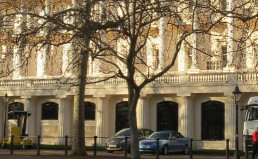
 Greek Doric columns, short and tall.
Greek Doric columns, short and tall.
The most characteristic element of Classical architecture is the pillar, and this page gives some examples of pillar sculpture, ranging from the 17th century through to the end of the Victorian era. Rather descriptive than looking to impart any great insight - to my mind, pillar ornamentation was an opportunity for sculptors to demonstrate their abilities and creativity in giving something new to a formal Classical style, and it is surprising to see the sheer number and variety in almot any town with buildings from the Victorian era.
Almost as soon as the enquirer meets Classical architecture, the three orders of Greek architecture are encountered the Doric, Ionic and Corinthian, all most easily recognised by their characteristic pillar designs, to which the Romans added two more orders the Tuscan and the Composite.

 Greek Doric columns, short and tall.
Greek Doric columns, short and tall.
To recap, Doric are the least ornamented, with simple square tops joined to the pillar column by some moulding, and, in the Greek Doric, lacking any sort of base. The column itself, called the shaft of the pillar, is typically fluted, or inscribed with small cut-outs, the depth, surface, and number of which were supposed to conform to strict rules. Rather short and solid (typically six or seven times as high as its diameter at the base, and visibly tapering towards the top), the Doric pillar is ideal for visibly supporting great weight, and where two or three orders of architecture are used piled one on top of the other, as in a tall building or tower, Doric is generally thought best for the lowest storey.
Ionic pillars are the ones with large scrolls at the top, sometimes facing directly to the sides as we look face on at the pillar this is often the case in 19th Century Classical buildings with Ionic pilasters (relief pillars used to break up the surface of a wall but generally not acting as structural supports). More usually, the scrolls, of which there are four, angle outwards from the square slab top resting upon them. Ionic pillars, which are also generally fluted, are a bit more slender than the Doric, say 8 times as high as their diameter at the base. We note that the depth of the capital with the scrolls, which curl down over the sides of the pillar tops, is very shallow that is to say, the capital adds very little to the height of the pillar as a whole. In our Victorian buildings, and earlier ones, this depth may be increased by putting in some extra moulding underneath, and perhaps a festoon of flowers hanging between the outward facing scrolls.
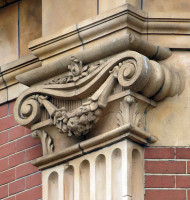
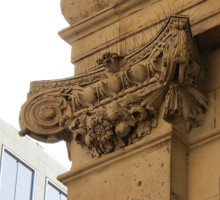 Ionic pilasters - late 19th Century, and 17th Century.
Ionic pilasters - late 19th Century, and 17th Century.
There may not seem much opportunity for sculptural adornment on the Ionic capital, but that is not the case, as we shall see.
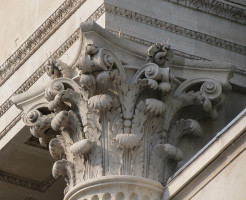
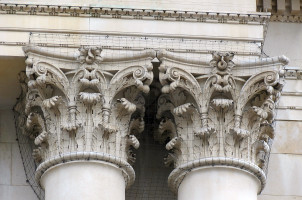
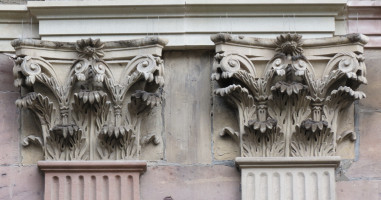 Examples of Corinthian pillars.
Examples of Corinthian pillars.
Corinthian is the most ornate and noble of Classical columns, taller and more slender, typically ten times as high as the diameter at the base, and with a rather deep capital, carved with the rather stylised leaf designs known as Acanthus, and usually with small scrolls at the top, smaller than in the Ionic and more numerous, facing inwards to the centre as we look at the pillar as well as outward to the sides. There is great opportunity for a variety of sculptural treatments of these capitals, and since Christopher Wren they have been a decorative opportunity unmissed in British architecture.
We should mention the two Roman additions. Tuscan is a variation of the simple Doric pillar, made even more simple, without fluting. Composite is more interesting, sculpturally speaking: a composite pillar combines the Acanthus leaves of the Corinthian with the scrolls of the Ionic. Corinthian pillars already have small scrolls, and Composite have larger ones; even so, the leafy Corinthian bit tends to dominate over the scrolly Ionic bit, so sometimes there is not so much difference between Corinthian and Composite, though in principle the Composite should be a more ornate pillar.
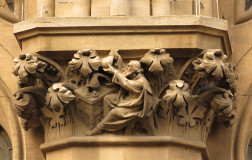 Pillar with sculpture of an alchemist.
Pillar with sculpture of an alchemist.
As mentioned, it is the Corinthian, and the Composite, which offer the greatest opportunity for further sculptural adornment. Above, on a pillar top loosely based on the Corinthian, we see a little statue of an alchemist of olden times, a cleric by his look. On his desk a great bound chest he is heading a retort, held by a clamp above a small flame. In his hands he holds a collection vessel, holding it up to see the quality or amount of product he has been able to distil.
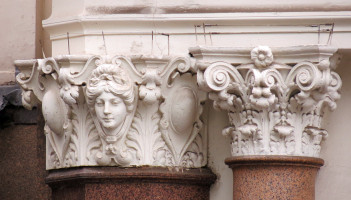
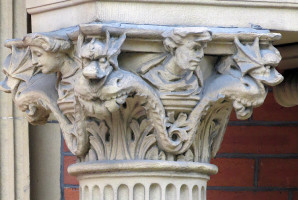 Sculpture added to a Corinthian base.
Sculpture added to a Corinthian base.
Above left is a pair of pillars; the one conventional Corinthian, the other adapted to hold small cartouches and a female head; the small scrolls have become almost a headdress for her, and the coverings for the cartouches; the Acanthus leaves are reduced to single, rather flat specimens. Above right, the Acanthus is bushier, and we have alternating pairs of monstrous heads, perhaps grotesque sea monsters, and conventional busts. Depending on whether we regard the busts as replacing scrolls or being in between them, we could regard this as a Composite column. More clear Composite column capitals are below. To the left, nicely carved ferns and flowers; next, an extreme vegetable example; then a case where the Corinthian Acanthus leaves are relegated to a small part of the capital, with splendid birds in between the Ionic corner scrolls; and to the right, a vertically compressed Composite capital with a plump head in the centre.
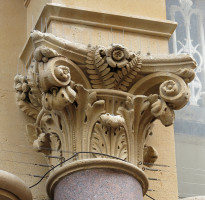
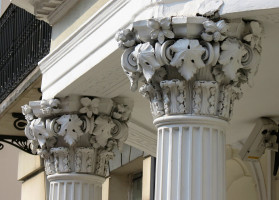
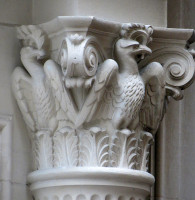
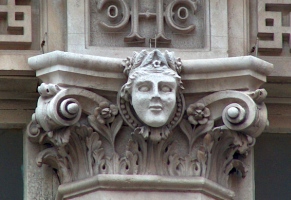 Composite pillars with sculptural decoration.
Composite pillars with sculptural decoration.
A few more examples of such Composite columns. Below left, a purely floral example, with trumpet like daffodils between the Ionic scrolls; next, a pair of bushily decorated capitals, with the Ionic scrolls holding flowers, and in between, fierce looking birds perched on the Acanthus leaves of the Corinthian element. Then a richly decorated Composite capital with rams heads, bearing excellently curved horns (if you are a connoisseur of sculpted goats then see this page. And below right, nude Bacchanalian figures, one with pan pipes, dance between the scrolls and over the front of the Acanthus.
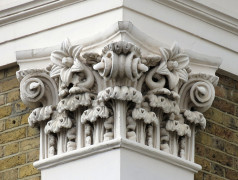
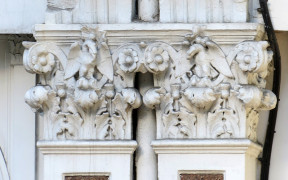
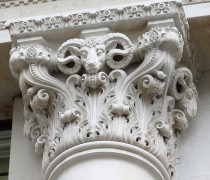
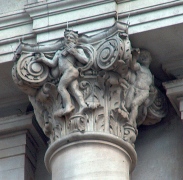 More decorated Corinthian columns.
More decorated Corinthian columns.
We can also have extra sculptural decoration on the Ionic capital. Below left, a conventional example with small festoon hanging between the two outward-facing scrolls, and above the centre, a flower, all being richer than the norm. Then a different sort of enrichment, with almost hypnotic fluting added to the scrolls, which incorporate small flowers, and with leafy sprigs between. The next two show a central cherubic head, and a full cherub seated between the scrolls. The next example has snarling dragons between the scrolls, which are adapted to extreme leafiness, and to the far right, a purely fern-leaf example, botanically thoughtful.
This last example above right brings us to the rather large class of purely leafy capitals, the leaves replacing Acanthus and scrolling and often making it rather meaningless to relate the pillar back to any particular order. Such pillars were much favoured in High Victorian times. Below are coupled pilasters with vineleaves; a capital with different leaves in Acanthus and scroll positions, an ornamental Acanthus and stylised four-petalled flowers, a beautifully twisted mix of stylised Acanthus and scrolling, and a group of three pilasters, each with a different vegetative capital, rather simple on their own but a pleasing and harmonious composition together.
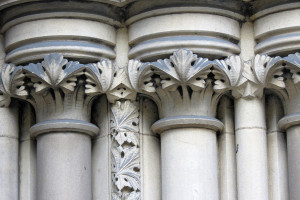
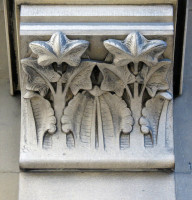
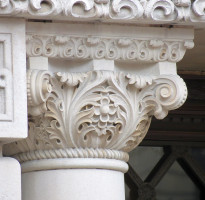
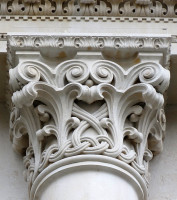
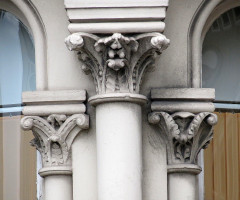 Pillar capitals with leaf ornamentation.
Pillar capitals with leaf ornamentation.
Before we finish with capitals, we must at least mention that more exotic classes of pillar were revived in the 19th Century. Below left is a pair of Egyptian columns flanking a window. Next, a more ornate Egyptian example, with carvings of a particularly characteristic palm leaf, curled over at the tip, and small split pomegranites part way up every second leaf; note the banana palm leaves behind. And to the right, an Abyssinian example with crowned bull.
Again in Victorian times, it became fashionable to decorate the shaft of the pillar, a style which had been popular in Medieval times. This was particularly favoured in terra cotta and faience designs, as in the three examples below.
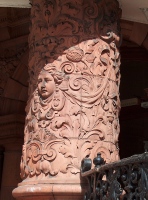
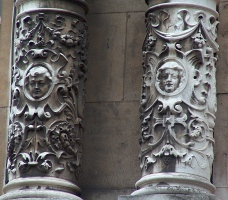
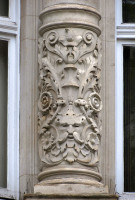 Pillar shaft decoration, terra cotta and faience.
Pillar shaft decoration, terra cotta and faience.
Three further examples of shaft decoration a restrained example with the decoration incised in a panel; another terra cotta example with hanging festoon, again constrained in a panel; and an example from art nouveau times, with a leafy tree with strange, organically writhing roots.
Finally, we note that sometimes the decorative element is put on top of the capital, in the space reserved for the entablature, within the entablature, if you prefer that term. Three examples below to the left, stages at the top of a brick pillar, with grotesque head in terra cotta; two bearded heads above a rather reduced Acanthus leaf, gloomy, bearded fellows with crowns; and an Ionic order with a grinning satyr and a head of Medusa above the pillars.
Architecture pages // Sculpture pages
Visits to this page from 13 Mar 2014: 4,799 since 26 May 2023